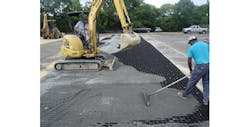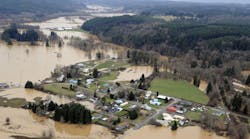The Power of Porous Pavement
When the engineering firm of HLA Inc. in Charleston, S.C., took on the job of renovating the alumni association’s parking lot at The Citadel, it faced two challenges. First, meeting the client’s desire for a low-maintenance, environmentally friendly alternative to the existing surface—a macadam pavement that had become compacted over time and had developed alligator cracking and potholes—that would service pedestrians and support vehicle traffic; and second, protect a nearby saltwater marsh and open-water tidal critical area from pollutants in storm water runoff from the site, despite the lack of space and time for constructing a conventional storm water detention pond in a low-lying area.
Solution
The engineers met this challenge by selecting a porous pavement system, GeoPave, designed specifically to confine and stabilize open-graded pervious aggregate infill inside a drainable structure. The strength of the confined mass of the aggregate supports the traffic load in concert with the load-bearing wall of the high-density polyethylene structure, while the voids in between the individual aggregate particles provide storage space for water, allowing runoff to infiltrate into the soil rather than flow off the parking lot bearing pollutants. In this case, that ability to soak up runoff eliminated the need for a storm water retention/detention pond that a concrete or asphalt pavement would have required.
The ability of the permeable GeoPave system to provide storm water infiltration and to reduce storm water runoff was especially valuable for this project, as The Citadel is located at sea level and extremely susceptible to flooding with even an inch or two of rainfall. The system helps reduce the impact on the parking lot by providing for underground storage of runoff.
The paver structure’s semi-rigid design provided several advantages. First, when filled with aggregate, the cells created a decorative randomized pattern design. Second, the monolithic mesh bottom keeps aggregate infill from migrating out of the bottom of the system and creates a snowshoe effect that contributes to the system’s load distribution. Third, the interconnected pavers create a strong load distribution layer that resists repeated traffic and torsional loading, as well as a surface that resists subgrade undulations and imperfections.
Results
HLA Inc. viewed this project as an opportunity to use new technology to provide an all-weather traffic surface without increasing runoff, as a hard surface pavement would. A porous pavement also offered a way to complete construction in just a few months. Surfacing the lot with concrete or asphalt would have required building a storm water retention/detention pond and constructing an outflow control structure to manage runoff flows from two-year, 10-year, 25-year, and 100-year storms. It would also have meant providing more vegetated areas to slow and help remove pollutants from the runoff before it entered the marsh. To gain the necessary space for this, it would have had to reduce the size of the parking lot, which was not an option.
Porous pavements reduce the amount of storm water design work required. The plan for the 57,064-sq-ft project included hard pavement for driving lanes and porous pavement for the actual parking areas. By making more efficient use of the parking lot space, the redesign increased the number of parking stalls from 80 to 117 and provided more grassed areas for treating runoff.


